In the shadow of the Napoleonic era. Danube knot of the Russian-Turkish war 1806 – 1812
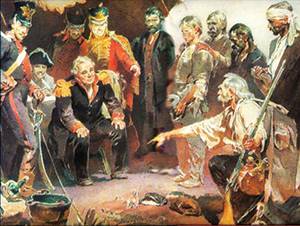
A huge raft with an elegant tent rocked on the waves of the Neman, and two emperors, who spoke the same language that day, slowly divided the map of Europe. We stopped our cast-iron discussion of the gun, giving the floor to the diplomats. For some time. The tranquility of the river, which suddenly became a border, was projected onto the ancient contours of the Golden Horn - the world came to the Ottoman Empire. The squadron of the Russian Tsar, like a wax cork on a jug of olive oil, which had clogged the Dardanelles, finally left its way. And merchant sailing ships, loaded with Egyptian grain, reached the starving Istanbul. The people calmed down little by little: why, every water seller knew that this is a new young Sultan Mustafa IV, may the Almighty prolong his days, help the French padishah Napoleon to make peace with Russia, otherwise he would not cope without any doubt. The war did not stop, but there was a victorious truce between the Turks and the Russians, because by the summer of 1807 there was almost nothing in Istanbul.
His Imperial Majesty Napoleon I, of course, did not suspect the honor rendered to him - to appear as an assistant to the great sultan himself - because he had enough worries without him. The most dangerous enemy, Russia, by military efforts was made, albeit conditional, but an ally. Though Alexander I’s ambition was a shadow of Tilsit, it was possible to redirect the attention of the Russian tsar towards unfriendly Sweden. The military successes of the Russians in relation to Turkey have been partially limited by the terms of the signed armistice. The position of Russia in the Mediterranean after Tilsit was frankly bleak. With a few strokes of the highest feather, victories, successes and efforts, dating back to the times of Ushakov, were leveled. According to secret articles, the Kotor district was transferred to the French. The same fate was prepared for the Ionian Islands, passing into the "full ownership and sovereign possession" of the Emperor of all the French. Alexander I, though wincing with annoyance, should have recognized the King of Naples Joseph Bonaparte, the emperor's older brother, the king of Sicily. In fact, the king was forced to agree with the French occupation of southern Italy, in advance approving the invasion of Sicily.
But the worst thing was, of course, the population of the Ionian Islands, who had Russian citizenship. With a guilty air, they were handed over to the French. The Russian fleet under the command of Admiral Senyavin, who until then had reigned supreme in the Aegean Sea, lost all of its bases and was forced to return to Russia. To do this in the new international environment, when the only allies — England and the king of the two Sicilies, Ferdinand IV — moved into the camp of enemies.
Against the background of a handful of bitter pills, which Russian diplomacy had to swallow, the stay of Moldovan army troops in the Danube principalities looked like a welcome point. According to numerous articles of the Peace of Tilsit, Russia pledged to withdraw its armed forces from Moldova and Wallachia. However, in the process of abandoning positions and withdrawing to the borders of the empire, Russian units began to be subjected to numerous attacks by Turkish irregular units. This fact was interpreted by Alexander as an insult to the honor of the Russian weapons, and the troops that began to retreat were ordered to return to their former positions. Napoleon, to whom Russia's loyalty was more important than some absolutely insignificant principalities for him, tacitly agreed with this disposition.
Skillfully directing the northern vector of the king’s foreign policy towards Sweden, which the French were ready to give (at least in words), even with Stockholm, in Middle Eastern issues Napoleon’s diplomacy showed itself as petty miser. From St. Petersburg they repeatedly signaled the extreme desirability of transferring the control of Russia to the Bosphorus and the Dardanelles. But Paris behaved exactly as the politician is doing now, who was asked an awkward question live: there were many words about friendship with Russia, mutual understanding, agreement and other rhetoric, but we could not get a direct answer.
Napoleon was not opposed to divide Turkey, but was not ready to give the Russians both the Bosphorus and the Dardanelles. In any case, the French agreed only on one strait, and certainly not on two. This was almost directly pointed out by the ambassador in St. Petersburg, Armand de Kolenkur. The parties frankly did not trust each other, using words of extortion. Perhaps, under other circumstances and with a more flexible position of France, Napoleon would have been able to gain closer support from Alexander and ensure his non-interference in European affairs. And the transfer of the gates so important to the Russian side from the Black to the Mediterranean would be more than a reasonable and fair price for not hearing the choral performance of a nightingale bird in the Rhine Valley. However, in the realities of those years, Russia and France turned out to be temporary and, moreover, suspicious companions in the world stage stories. Napoleon became more and more entangled in his European affairs: it was difficult to build an empire, but to keep it under control was almost impossible. Under the blinding sun of Castile and Andalusia, the gold of the imperial eagles dimmed, and battalions hardened in battles melted from the merciless lead of guerillaces, heat, disease, and useless efforts. The continental blockade, which Napoleon so zealously strove to maintain, ravaged not only the English merchants and bankers, but also killed the intra-European market. Generously fueled by English gold, Austria straightened the bayonet bent in recent failures in order to thrust it into the back of France, which is bent in a Spanish swamp. And there was also the numerous and noisy relatives of the emperor, thirsting for money and titles, quarrelsome and intriguing against each other, by the very fact of their existence creating a big problem.
Despite the fact that Alexander, with the full approval of his French partner, took up the traditionally unfriendly Sweden in order to push the border away from St. Petersburg for the foreseeable future and get rid of the uncomfortable neighborhood, the remaining unsolved number of problems in relations with Turkey did not disappear from the high metropolitan offices. Especially since the Splendid Port itself was far from inner peace and pacification.
The coup in Istanbul. Stupid diplomacy
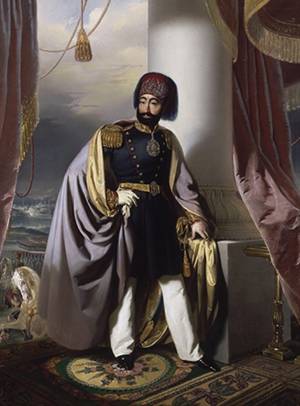
So, neither Russia nor Turkey was satisfied with the truce. The Russians, having achieved significant success in the Balkans, and thanks to the actions of the squadron Senyavin, rightly wished to continue the successfully begun campaign, because, as the Prussian king Frederick II used to say, the forest that was not cut down to the end sprouts. The Turks traditionally craved revenge. Negotiations on a full-fledged peace, conducted through French mediation in Paris, were interrupted, as Napoleon departed for Spain, where his presence was a greater necessity. At the beginning of 1808, negotiations were resumed, and the Turkish side was represented by the most influential dignitary, Pasha Ruschuka, Mustafa Bayraktar.
Pasha did not belong to the typical representative of the highest Omani leadership and bureaucracy, the main joy and anxiety of which revolved around the size of officially presented and unofficial gifts, as well as the quantity and quality of the personnel of their own harem. Mustafa Bayraktar was an outstanding personality and understood that without reforms the Ottoman Empire was doomed to rapid degradation and decay. With the beginning of the Russian-Turkish war, he was appointed to the responsible post of commander of the Danube army. After the overthrow and imprisonment of Selim III under house arrest at the end of 1807, Pasha organized in Istanbul a kind of like-minded society, which received the unofficial name of “Ruschuk friends”. It was in the modern sense of the political circle, which included supporters of the overthrown Selim III, the adherents of the reform course. The young Sultan Mustafa IV did not possess, in the opinion of Rushchuksky pasha, the traits necessary to bring the country out of the political, military, and economic deadlock. The power of the government was frankly weak; Mustafa IV did not enjoy popularity in the army. The opposition, relying on bayonets and yatagans, gradually gained strength - in July 1808, Bayraktar headed the troops loyal to him and entered Istanbul and humbly forced the terrified Mustafa IV to appoint him to a place more similar to the generalissimo post. Ruschuksky Pasha becomes in fact the commander of all the armed forces of the empire. Clearly understanding the direction in which the increasingly foul-smelling wind is blowing, and watching the ranks of yesterday’s friends and comrades swiftly rushing to the side of Bayraktar, which has real power, the sultan orders to strangle political prisoner Selim III and, for loyalty, his young brother Mahmud. Selim was killed, but his brother was more fortunate: he managed to hide from the expenditure team in the furnace of the bath.
Having learned about the intentions of Mustafa IV to legitimize power by not entirely legal means, Rushchuk Pasha began decisive action. The sultan's palace was taken by assault, Bayraktar arrested the sultan, and having found the frightened young man Mahmud, urgently - from sin and distemper away - proclaimed him the sultan under the name of Mahmud II. The thirtieth ruler of the empire was the second son of a pious and quiet royal reclusive, Abdul-Hamid I and his fourth wife, supposedly of French origin, Naqshidil. The mother of Mahmud II, who had a great influence on the political and state views of her son, remained a mysterious and legendary person in the history of Turkey. According to one hypothesis, under the name of Nakshidil, in the sultan's harem was the daughter of a planter from Martinique Aime du Bouc de Riveri, a distant relative of Josephine de Beauharnais, Napoleon’s first wife and French empress. De Riveri was raised at a Carmelite sisters monastery, in the summer of 1788 she left France on a ship and has since been considered missing. It is assumed that the ship was captured by Berberian pirates, and the Frenchwoman herself ended up in the sultan's harem. It is also known that the mother of Mahmud II was perfectly educated, fluent in French and instilled in her son interest and love for European culture.
The young sultan immediately understood whose advice he should listen to in order to avoid a silk lace. The policy of reform was officially taken, primarily in the army, which it was decided to bring to the European model. The traditional pillar of the throne, the janissary corps, no longer represented the invincible force that it was before, being, by and large, an archaic relic and a kind of monument of the greatness of the Ottoman Empire. The Janissaries were completely re-equipped with the newest European-made small arms and received a new uniform. The vastness and depth of change unpleasantly struck the Sultan's Guard, which soon resulted in another rebellion.
In November, 1808 in Istanbul, there was another coup attempt. This time, the traditionalist conspirators, relying on the Janissaries' discontent, tried to return Mustafa IV, who was still imprisoned, to the throne, but with the ousted ruler they acted no less brutally than he acted in relation to his cousin. The morals at the Sultan's court traditionally did not differ in humanism and mercy, therefore, by the order of Mahmud II, his predecessor was strangled. The rebellion was suppressed, suspiciously scurrying local governors lead to submission or execution. Ruschuksky Pasha Mustafa Bayraktar did not survive the next coup d'état - he died in his own palace set on fire by the rebel janissaries. Nevertheless, the course of reform was continued.
Negotiations with Russia, going shaky or not, after the coup in July 1808 were interrupted. Mahmud II wished for the resumption of hostilities, despite the admonitions of Rushchuk's pasha, who believed that militarily, Turkey was not yet ready for war. The negotiation process gained new momentum after the new meeting of Napoleon and Alexander in Erfurt, but with the death of 1808 in November, Mustafa Bayraktar frankly slowed down. Turkey took a stubborn and uncompromising position on a number of issues, primarily the military, which was completely unacceptable for the Russian side. Istanbul went on a direct rapprochement with Austria and England - with the latter even an alliance was concluded. In Europe, more and more began to smack of another war, the position of the Turks became more and more categorical, until, finally, 29 March 1809 was issued a sultan's firm declaring war on Russia.
Resumption of hostilities
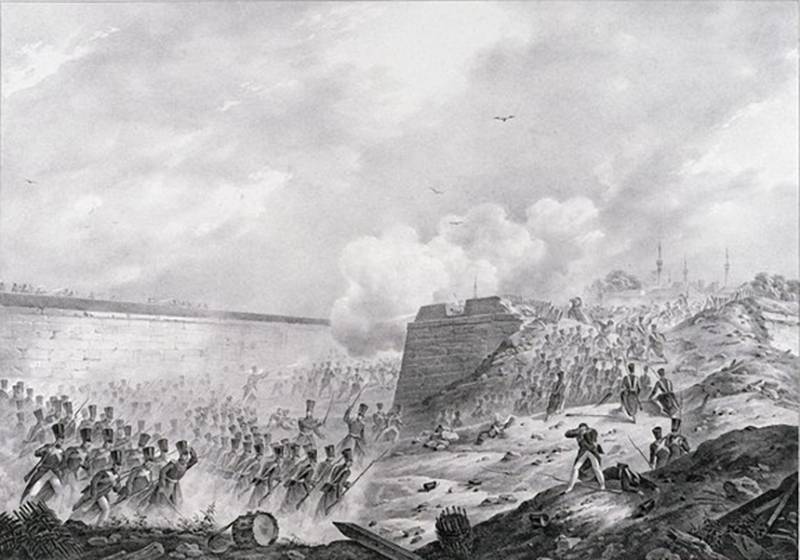
The conclusion of peace with Napoleon, albeit forced and far from the most profitable, allowed Alexander I to gradually concentrate on the Danube almost 80-thousandth group. The 68-year-old Russian commander, the suppressor of Pugachev, I.I. Mikhelson, had died in Bucharest by this time, and 76-year-old Field Marshal Prince A.A. Prozorovsky was appointed in his place. The motives for appointing a commander of a more than respectable age, especially against the background of the young Napoleonic marshals, are not easy to understand. Lev Tolstoy on the pages of "War and Peace" through the mouth of one of the characters with biting irony explains it this way: "In total, we are in abundance, lacking only a little thing, namely, the commander in chief. As it turned out that Austerlitz’s successes could have been more decisive, if the commander-in-chief were not so young, then an overview of 80-year-old generals is made, and the latter is chosen between Prozorovsky and Kamensky. ” In general, choose the one that is older. Perhaps the king had reason to beware of young ambitious generals who could win fame winners and bypass the sovereign, whose military-political "actions" after Tilsit and Erfurt fell heavily. A number of historians, for example, Tarle and Manfred, indicate that the king repeatedly received anonymous letters, where in transparent hints indicated a greater likelihood to repeat the fate of his father in the event of continued friendship with Napoleon. Therefore, perhaps, the king, in need of such people, at the same time was afraid of them.
Nevertheless, 64-year-old Mikhail Illarionovich Kutuzov, almost young against his background, was sent to assist Prince Prozorovsky. The Russian war plan was comparatively simple and effective: to seize the Turkish fortresses on the Danube, force this water barrier, go to the Balkans, defeating the Turkish army, and force the Ottoman Empire to a favorable world for itself. Unfortunately, by this time in the Aegean there was no longer a squadron of Admiral Senyavin, so successfully and, most importantly, effectively blocking the Turkish capital. Black Sea Forces fleet were limited in numbers and were not ready to gain supremacy at sea.
At the end of March, the 1808 corps of Kutuzov's corps marched from Focsani to the fortress of Brailov, where the 12-thousandth Turkish garrison, which had 205 guns, was located. 8 April, the corps approached the walls of the fortress, however, after conducting a reconnaissance and analysis of the enemy fortifications, Kutuzov came to the conclusion that the forces under his command were not enough for an assault. His corps did not have siege artillery and had all 30 field and 24 light horse artillery guns available. Kutuzov reported his conclusions to Prozorovsky, but he did not cancel his decision and arrived at Brailov himself to personally command the troops.
The Russian army began a systematic siege of the Turkish fortress: the construction of fortifications and batteries began. On April 11, a siege park arrived under Brailov, 19 armed launches of the Danube Flotilla pulled up along the Danube. 17 on April made a systematic bombardment, and on the night from 19 to 20 an assault was attempted. The operation did not work out from the very beginning - the signal for the attack was mistakenly given four hours earlier. Russian troops suffered very significant losses: almost 2,5 thousand killed and as many wounded. The failure greatly distressed Prozorovsky, who, according to eyewitnesses, fell into a full hypochondria. However, restoring peace of mind, the prince laid all the blame for the unsuccessful attack on Kutuzov. As a result, Mikhail Illarionovich was removed from the command of the corps and appointed Vilna governor. In early May, Prozorovsky lifted the siege from Brailov and was inactive for almost two months.
At that time, a rebellion led by Karageorgia continued in Serbia. Taking advantage of the passivity of the Russian command, the Turks managed to transfer over 70 thousand troops to Serbia and inflict a number of significant strikes on the rebels. Only at the end of July Prozorovsky forced the Danube - Russian troops occupied the Turkish fortresses Isaccea and Tulcea.
On August 9, Prince Prozorovsky died in a field camp beyond the Danube, a new infantry general, Prince Bagration, was appointed new commander. The prince received this post for a reason, and under some piquantly scandalous circumstances. At court, the novel of a war hero with the French and 18-year-old grand duchess Catherine Pavlovna, sister of the emperor, was publicized. In order to neutralize the amorous crisis that had arisen (Bagration was married), the grand duchess was immediately married to her cousin, Duke George Oldenburg, and Bagration was sent away from the capital to Prozorovsky in the Moldavian army. 25 July 1809 the general arrived at headquarters, and soon the elderly commander surrendered command naturally.
The first operation of the Russian army under the leadership of Bagration was the siege of Machin fortress. On August 14, a Russian detachment commanded by Lieutenant-General EI Markov, as part of 5, thousands of people with 30 guns approached the fortress. The 16 August bombardment was launched, and the 17 numbers approached the ships of the Russian Danube Flotilla. Soberly weighing their chances of success, the next day the Turkish garrison capitulated.
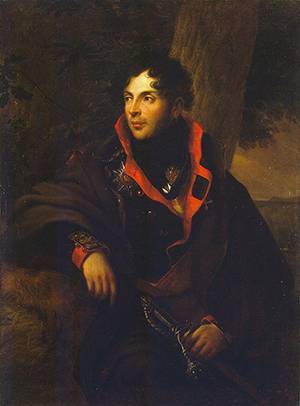
At the end of August, a five-thousand-man detachment of General Sass began a siege of Ishmael, where the 4,5-thousandth Turkish garrison was located, which had more than 200 guns. A daily bombardment of the fortress began, which the Danube Flotilla soon joined. On September 13, commandant Ismail Celibi-Pasha proposed to start negotiations on the surrender, and the next day Russian troops captured this powerful fortress, in which impressive trophies were taken in the form of guns, Turkish rowing ships and large stocks of gunpowder and nuclei. The garrison, under the terms of surrender, went to the Turkish side.
Meanwhile, 4 September 1809 g. Bagration inflicted a decisive defeat on the enemy under Rasovo, forcing 12-thousand to retreat. the Turkish corps, and on September 11 began a siege of the Silistria fortress. The enemy commander, Grand Vizier Yusuf Pasha, was forced to transfer his army to the right bank of the Danube and withdraw a large contingent from Serbia. In early October, the Turks were able to concentrate about 50 thousand people under Rushchuk, who were preparing to throw under Silistria. Between the Russian and Turkish cavalry units clashes occurred. Bagration received information that the Grand Vizier with a large army was moving from Ruschuk, while he himself had no more than 20 thousand people. This and other circumstances, in particular, the ever-increasing shortage of provisions, forced Bagration to lift the siege of Silistra and to withdraw to the left bank of the Danube. This event gave Alexander I a reason to remove the prince from command. Although the complex relationship with the corps commanders - Miloradovich and Lanzheron - played a much more tangible role in the new personnel reshuffle. Count Langeron, a French émigré, had long been noted for his passion for intrigue. With Miloradovich, Bagration had a personal conflict, including due to the not quite restrained behavior of Miloradovich in Bucharest. In January, 1810, Mr. Bagration, secured his recall, but already in February he was sent to rest for two months from work. The fourth commander of the Moldavian army was General of the Infantry N. M. Kamensky, the second, the son of the very “seventy-year-old” field marshal M. F. Kamensky.
Campaigns 1810 and 1811 and the end of the war
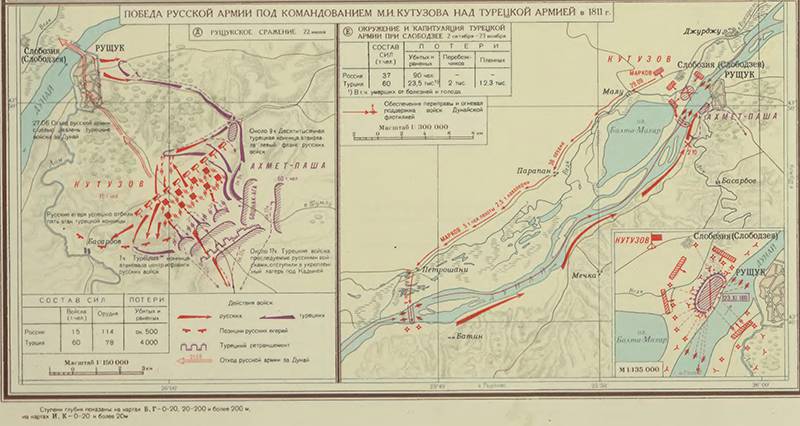
The campaign plan for 1810 year provided for the mastery of Shumla, and under favorable circumstances, Ruschuk and Silistria. In May 1810, the main forces of the army crossed the Danube and began the siege of Silistra. 30 May fortress capitulated. The offensive of the Russian army continued - soon Kamensky was surrounded and besieged Rushchuk. Attempting a poorly prepared assault on 22 in July. 1809 was not successful and cost the Russian army considerable losses. To release Ruschuk, the 30-thousandth army of the Kushan-Pasha was sent. In early August, the Turks took up positions in a small town Batin. Kamensky pulled up around 21 of thousands of his troops here and on August 25 attacked the enemy. The Russian Danube Flotilla provided active assistance to its army. An attempt to attack the Rushchuk garrison was neutralized by the troops of General I. N. Inzov. The bloody battle continued until the evening, and in the end the Turks began to retreat - they were actively pursued by the cavalry. The Turkish redoubt, where one of the enemy military leaders Ahmet Pasha and more than 500 Turks strengthened, resisted for almost a day, after which the surrounded enemy laid down his arms. The total losses of the deblocking army were estimated at 5 thousand dead and wounded, while the Russians lost 1,5 thousand people. After this battle, the garrison of Ruschuk capitulated. Kamensky Alexander I granted the Order of St. Andrew the First Called. In November 1810, the city of Kamensky, leaving strong garrisons in the occupied fortresses, took the army to the left bank of the Danube, to winter apartments.
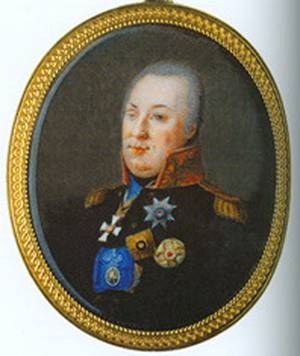
The launch of the 1811 campaign took place in an increasingly deteriorating international environment. Relations with France became more and more cool and wary. More and more rumors about an imminent war with Napoleon. England, which continued, on the one hand, formally to be in a state of war with Russia, and on the other, being an ally of Turkey, helped Mahmud II with money, for which the sultan not only fought with the Russians, but also suppressed the Serb uprising. The protracted war with the Turks had to end at a rapid pace, and for this purpose a sensible, energetic and, most importantly, capable commander was needed. Such a man, fortunately, Alexander I was. Mikhail Illarionovich Kutuzov was ordered to leave the troublesome leadership of the Vilna general governorship and go to command the Moldavian army. Kutuzov was already the fifth in this troubled post, about which amusing jokes were being written in St. Petersburg salons.
7 April 1811 Kutuzov arrived in Bucharest and took command. The task of the new commander was complicated by many factors, primarily due to a significant reduction in the forces at his disposal. Five divisions from the Moldavian Army were deployed to the western border, and now there were hardly more than 40 thousand men. The Turkish group of great vizier Ahmed Pasha, who had to cope with Kutuzov, doubled his army and consisted of 80 thousand people. Russian troops were also heavily smeared around the theater of military operations - some of them covered ferries across the Danube, some were located in garrisons.
Kutuzov decided to gather his forces into a fist, and, waiting for Ahmed Pasha's offensive, to inflict a decisive defeat on him. The fortifications of Silistra and some other fortresses were razed, the garrisons were withdrawn, and the main forces of the Russian army were concentrated between Bucharest and Ruschuk. In early June, 1811, the Turkish army of Ahmed Pasha, approached Rushchuk on 15 km, where it became a camp. Upon learning of the approach of the enemy, Kutuzov secretly from the Turks sent his forces to the right bank and took up positions in 5 km south of Ruschuk. The Russians had about 16 thousand people with 114 guns against nearly 60-thousand Turkish army, which had, however, only 78 guns. 22 June 1811 The troops of Ahmed Pasha, with the support of artillery, attacked the Russian army. However, the attacks of the enemy were poorly organized - the indiscriminate onslaught of the Turkish cavalry was repulsed by the Russian infantry, built into the battalion squares. The battle lasted almost 12 hours, after which the unsuccessful Turks were forced to retreat to their camp. Russians lost about 500 people, opponents of more than 4 thousands. Shortly after the battle, Kutuzov became aware of a possible crossing of the 20-thousandth army of Ismail Bey at Vidin and the invasion of Minor Wallachia. 27 June Russians left Ruschuk, which left the local population. Blowing up all the fortifications, Kutuzov moved to the left bank of the Danube.
The operation of Ismail Bey failed for Vidin - the Russian detachment disrupted the crossing attempt. Upon learning of this failure and completely mistakenly believing that Kutuzov’s departure to the left bank was caused by the weakness of his army, Ahmed Pasha began on August 28 crossing his army across the Danube. This was fully included in the plans of the Russian command - to surround and defeat the Turks. September 1 on the left bank was already about 40 thousand enemy soldiers and 56 guns. The remaining 20 thousand remained so far on the right bank, in the main camp. The infantry that had crossed over built a retractor, dug field fortifications. While the Turks settled down, Kutuzov pulled up thousands of people with 37 guns to the site of the upcoming 133 events. Communication between the camps of the enemy began to actively interfere with the Danube Flotilla.
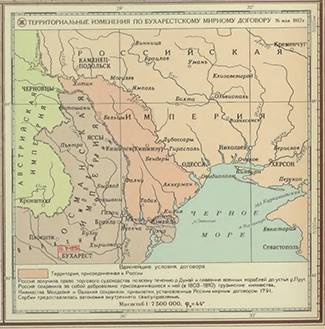
The plan of the Russian commander was to pin down the Turks on the left bank with the main forces, and partly to secretly force the Danube, strike from the rear and defeat the enemy. For the implementation of the bypass maneuver, the corps of General Markov was distinguished: 18 infantry battalions, 10 squadrons, 2 Cossack regiments and 47 guns. On the night of October 1, Markov secretly from the Turks (intelligence from Ahmed Pasha was organized very badly) crossed over to the left bank in 6 km from the Turkish camp. On the morning of October 2, the Russians launched an offensive and soon broke into the main enemy camp. For Ahmed Pasha, this was a complete surprise. The troops stationed here were unable to organize resistance, and fled in panic. Markov, setting up his guns and adding to them the captured ones, soon established shelling of the Turkish positions on the right bank. 40 Thousands of Turks were virtually completely surrounded.
Constant bombing began, joined by the Danube Flotilla. Soon a famine began in the blocked army, followed by a massive loss of horses. October 5 Grand Vizier, leaving the army surrounded, fled from the boiler on the boat. After some time, Ahmed Pasha offered Kutuzov to begin negotiations on a truce. Kutuzov hesitated with the answer, declaring that he needed a full-fledged peace treaty, and besides, time was clearly working for him. Information about the impending catastrophe quickly reached the highest Turkish authorities, and a truce was signed by the parties on October 13. Began a lengthy negotiation of peace.
The losses of the surrounded group for August-October were 23,5 thousand killed, dead and wounded and about 12 thousand prisoners. Negotiations in Bucharest were quite difficult. On the one hand, Russia, on the eve of the war with Napoleon, needed to free their hands, on the other hand, France was pressed against the Turks, who did not want the war to end. Finally, on May 5, a peace treaty was signed in Bucharest in 1812. The river Prut and Dniester - Bessarabia moved to Russia. Now the border between the empires passed along the Prut River. Moldavia and Wallachia remained part of Porta, but with all the privileges secured by the Yassky peace treaty 1791, Serbia received wide autonomy. The conclusion of peace took place on time and had to be very helpful. The colossal size of the army of two languages was already preparing to cross the Neman, and a short man was already leaning towards a map with names that were difficult for a foreigner to pronounce. Before the “thunderstorm of the twelfth year” there remained a little more than a month.
Information